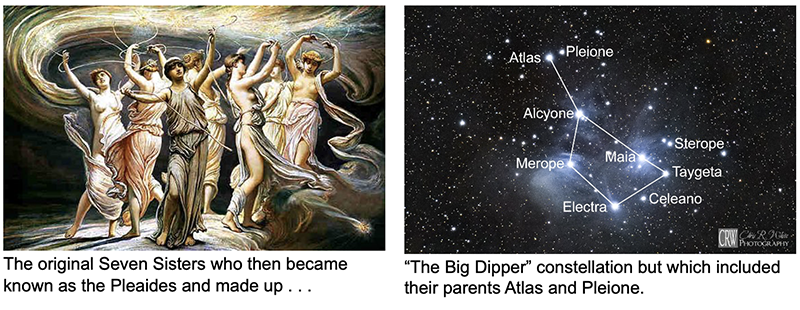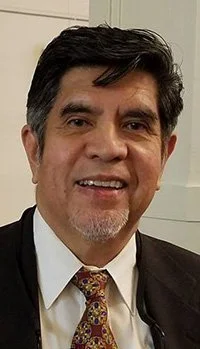In Seventh Heaven on Mother’s Day
/I made my own lists of Oscar winners; of global cities with subways or revolving restaurants I would someday visit; which Manila families had their own private helicopters; the global meanderings of one Imelda Marcos in the “so-called selfless” service of her people as I knew she was skimming from the taxes my parents paid to pay for these jaunts; and sundry trivia that would serve me well in later years.
A lot of that fact-collecting centered on the magical, mystical number “7.” There were the seven days of the week; seven ancient wonders of the world. Other than the Trinity, this young Catholic school boy was learning about: • seven cardinal sins • seven virtues • seven sacraments • seven continents • the seven seas • seven leagues • seven modern wonders of the world • siete pares ambicion (7 pairs objective) in mahjong • Snow White and the Seven Dwarfs/ves (OK, little people) • Salome’s Dance of the Seven Veils • the seven hills of Rome; • Seventh Day Adventists, etc..
In 1954, a very influential movie musical Seven Brides for Seven Brothers, caught my attention. Since I was the oldest and only had two younger brothers, I always marveled–I guess secretly envied–the camaraderie of many more siblings. And then the even more magical The 7th Voyage of Sinbad came out a few years later.
Ancient Greek mythology supplied us with the first grouping of “seven sisters.” The Seven Pleaides – Maia, Electra, Taygete, Alcyone, Celaeno, Sterope and Merope. (But why were there nine Muses? Was that two too many? Surely, a topic for another day.)
Since I never had real-life sisters, I kept hearing of the “Seven Sisters” of US higher education: seven exclusive, private colleges who offered liberal arts courses for American women: Barnard College (NYC), Bryn Mawr (PA), Mount Holyoke (MA), Radcliffe (Cambridge, MA), Smith (Northampton, MA), Vassar (Poughkeepsie, NY) and Wellesley (MA). These are where the daughters of America’s upper class were educated.
There are the corresponding Seven Ivy League schools: Brown, Columbia, Cornell, Harvard, Penn, Princeton and Yale.)
Manila almost had the same sisterly constellation of exclusive colleges for Filipina women. In both pre-World War II and in the early Republic decades, there were seven leading sectarian all-girls’ colleges of foreign provenance: Assumption Convent (French nuns), Holy Ghost/Spirit (defunct German), Maryknoll / later Miriam (American), St. Scholastica’s (German), St. Theresa’s (defunct Belgian), St. Paul (also French) and Colegio de Sta. Isabel (Spanish-Daughters of Charity).
For the record, Colegio de Santa Isabel is the third oldest continuing, educational institution in the Philippines. Initially a Music school, Sta. Isabel was founded in October 1632, twenty years after the University of Santo Tomas (1612), and only twelve years after Colegio de Letran (1620). A full-service, co-ed college today, Sta. Isabel would be celebrating its 400th anniversary in 2032. It is thus the oldest formerly women’s college in the Philippines, and possibly Asia.
And then I was industrially inspired. I learned there were seven even more “butch” sister entities—the Seven Sisters oil companies (up to around 1985): Esso (later Exxon); MobilOil (formerly Standard Oil of New Jersey); Texaco; Gulf Oil, Shell (Royal Dutch); Standard (formerly Standard Oil of New York) and BP-British Petroleum (formerly the Anglo-Persian Oil Co.).
I now switch gears now real-life “seven siblings” phenomenon.
As mentioned, I never had sisters and have only two younger brothers in this life. So, the concept of larger families swirled around me but was never within reach. And it was not until the final years of my mother, Lydia, did I become conscious that actually, on her side, I was sort of touched by that septieme heritage because after I did a last-minute head count, she turned out to be the fourth daughter of eventually seven consecutive Molina sisters.
As far as I could remember, there were only six maternal aunts I interacted with: Carmen, Natividad, Luz, my mother Lydia, Ines, and Juliana, the youngest. However, as I learned later on, Ines was part of a pair of twins (her twin, Juliana I, did not survive infancy). Thus, when another daughter followed the deceased twin, she became Juliana II. Incidentally, three of my Molina aunts were schoolteachers by trade.
First Alma Mater
In keeping with this Mother’s Day educational theme, I was the scholastic product of a rather advanced but small-town elementary institution called St. John’s Academy (SJA) in what is today San Juan City. Established in the 1930s by seven sisters whose parents, the Gregorio Marquezes, were among the first set of Thomasite graduate-teachers who helped establish the Philippines’ educational system.
Thus, my first real alma mater was the very distinguished St. John’s Academy. Initially I thought alma mater (using a pidgin Spanish/Latin hybrid) meant “soul mother.” But more correctly, alma mater, when referring to an institution of learning figuratively means “nourishing mother.”
The founding seven Marquez sisters of SJA–the foundations of my learning–were Socorro (Zaballero), Concepcion (Gil), Lina (Olivera), Pacita (Paz Benitez), Natividad (died young), Dolores (Carballo) and Isabel Marquez. In my seven years at SJA, only Mrs. Gil and her two youngest sisters were actively teaching and running the school. As with my Molina aunts, no photos of the seven Marquez sisters all together are extant. Today, SJA is run by the 3rd generation of Gils.
Above is the updated 21-century reiteration of the SJA logo I so fondly remember. In its older iteration, it had the center graphic which was symbolic of the nucleus of an atom but had (if memory serves me right) only “San Juan, Rizal.” The seven “atoms” in the middle of the fusion graphic, were the original seven Marquez sisters.
Despite its name, SJA, which traces its founding year to 1930 was never a religious order-run school. The Marquezes named it not as a tribute to St. John the Baptist (after whom the town is named) but to San Juan the municipality, even going so far as to name it like St. John’s, Newfoundland). And the fact that it was a non-sectarian academy was what prompted my parents to enroll me for elementary school.
Some images from the St. John’s Academy campus in San Juan City, Metro Manila, today. Top left is a bust of Mrs. Concepcion Gil, who was the longtime Administratix/Director of SJA; buildings around the campus which I no longer recognize. (St. John’s Academy Photo)
Because of its hemmed-in and limited campus size of one-hectare, St. John’s managed to remain a small, selective school. Thus, it can pick and choose its faculty and students with great discernment and pair well-chosen teachers with smaller-sized classes to the great benefit of its students.
When I completed my elementary years there, SJA was right up with the larger established schools in the country—like Ateneo de Manila, St. Theresa’s and American School, in terms of academic standing—which is why I was able to enter into the Honors Section immediately when I transferred to Ateneo for high school.
Of the seven (!) schools I have attended in my lifetime, I look back and recall that SJA was perhaps the most decisive and formative (one) of my life. Thus, I find it particularly appropriate to reminisce and celebrate the school’s 95th anniversary this year.
Seventh Son Syndrome
In 2014, a Dungeons and Dragons-and-sorcery film centered on the fate of the seventh son of a seventh son. True to its genre, the hero was nearly immortal and, of course, the envy and target of darker, more sinister forces.
This set me thinking: how great would it be if I were the seventh son of a seventh son? This seemed like an unassailable double anting-anting (double good-luck charm or talisman) to carry all through life, but you would have to come from a special place to achieve that. And actually, back in Manila, we were friends with another Garcia family—no relation—who ended up with eight sons, no daughters. But in the next generation, their seventh son had no issue, so the legendary lineage could not continue.
Stars and Spheres Align
Flash forward a few decades, and I have settled into a new life in the US. Thanks to St. Internet, I was able to reconnect with larger circles of relations on my father’s side as I never had back in the old sod. Thanks to the world-wide-web, I connected with the del Fierro clan later in life. What do they say? Better late than never.
And that is where and how I finally found my seventh filial moorings. While not vertically descended, but by a second or third-degree, I belatedly found that I had a set of seven great-granduncles to brag about. My paternal great-grandmother was one Tranquilina del Fierro, and it was from her brother, Eugenio del Fierro, that the more prolific relations come from. So, allow me, dear reader, to revel even on the outer edges of a seventh-son phenomenon.
My seven great-grand-uncles and great-grand-aunt, December 1953, Iba, Zambales. Inset (Miguel) was supposedly out at sea when this reunion occurred. They were first cousins of my grandfather, Dr. Arturo del Fierro Garcia. Sadly, I never met any of them. (del Fierro clan photo collection.)
By the late-life connections with this far-flung clan starting in 1998-99, I even learned even more about our roots from mainland Spain, to the Canarias, through Mexico, to old Spanish Philippines. In the waning years of the 20th century, the far-flung branches of the family tree reaching to North America, Australia, and Europe would soon connect. Thus, by the photo above, I am slightly “touched” by the seventh-son nth degree.
As I write this piece, I am grooving most fittingly to the heart-achingly sublime rendition of Antonin Dvořák’s masterpiece, Songs My Mother Taught Me.
My mother, Lydia, turned out to be the fourth daughter of eventually seven consecutive Molina sisters.
Third Time’s A Charm?
Some 20 years ago when I went for a spiritual reading (with an ancient spirit as the interlocutor), the spirit guide advised me that this present life was my third go-around between my late mother Lydia and myself. In the overall scheme of karmic matters, that is supposedly a highly, highly unusual occurrence.
The author, at seven+ months old, with his mother, Lydia, November 1948. (Author’s personal collection.)
I like to think that my mother would still be watching over me. Also, coincidentally this is my 77th article for www.positivelyfilipino.com in my 77th year. How cosmic can that be?
Here’s looking at you, Mama!
SOURCES:
Santa Isabel College - Manila
St. John's Academy Jobs and Careers, Reviews
Myles A. Garcia is a Correspondent and regular contributor to www.positivelyfilipino.com. He has written three books:
· Secrets of the Olympic Ceremonies (latest edition, 2021);
· Thirty Years Later . . . Catching Up with the Marcos-Era Crimes (© 2016); and
· Of Adobo, Apple Pie, and Schnitzel With Noodles (© 2018)—all available in paperback from amazon.com (Australia, USA, Canada, UK and Europe).
Myles is also a member of the International Society of Olympic Historians, contributing to the ISOH Journal, and pursuing dramatic writing lately. For any enquiries: razor323@gmail.com
More articles from Myles A. Garcia












